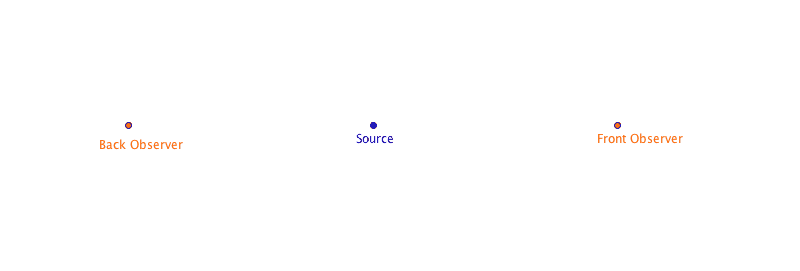The Doppler Effect
The doppler effect is a feature of waves that occurs whenever there is relative motion between the source of sound and an observer. It will cause an increase in frequency heard by an observer when the source is moving toward the observer and a decrease in frequency heard by an observer when the source is moving away from the observer.
The doppler effect can be observed when an ambulance with a siren on approaches and passes an observer. The siren will appear to have a higher pitch as it approaches the observer and then a lower pitch as it passes the observer and moves away.
The following animations illustrate different situations where sound waves are being emitted from a moving source:
Sound Source Moving Slower than the Speed of Sound

Sound Source Moving at the Speed of Sound

Sound Source Moving faster than the Speed of Sound

The Doppler shift equation:

where:
![]() = the apparent or observed frequency (Hz)
= the apparent or observed frequency (Hz)
![]() = the original frequency (Hz)
= the original frequency (Hz)
![]() = the speed of the waves in the medium (in
= the speed of the waves in the medium (in ![]() ).
).
![]() = the speed of the observer relative to the medium (in
= the speed of the observer relative to the medium (in ![]() ). It is positive if the observer is moving toward the source and negative if the observer is moving away from the source.
). It is positive if the observer is moving toward the source and negative if the observer is moving away from the source.
![]() = the speed of the source relative to the medium (in
= the speed of the source relative to the medium (in ![]() ). It is positive if the source is moving toward the observer and negative if the source is moving away from the observer.
). It is positive if the source is moving toward the observer and negative if the source is moving away from the observer.
For the purposes of sound waves, the velocity of sound in air = 340 ![]()
Example 1:
A police siren emits a sound with a frequency of 2000Hz. What frequency of sound does an observer hear if:
a) The observer is stationary and the police car is moving toward the observer at 15 ![]() ?
?
b) The observer is jogging away from the police car at 4![]() and the police car is travelling toward the observer at 25
and the police car is travelling toward the observer at 25![]() ?
?
Answers:
a) ![]() = 2000Hz
= 2000Hz
![]() = 340
= 340 ![]()
![]() = 0
= 0 ![]()
![]() = 15
= 15 ![]()


![]()
b) ![]() = 2000Hz
= 2000Hz
![]() = 340
= 340 ![]()
![]() = 4
= 4 ![]()
![]() = 25
= 25 ![]()


![]()
